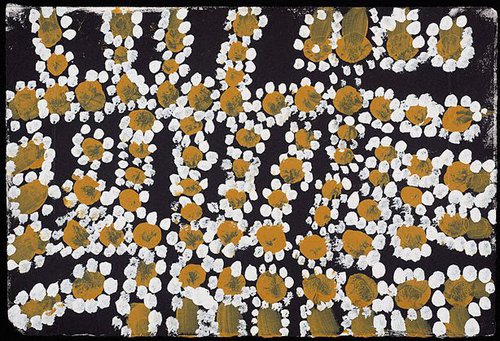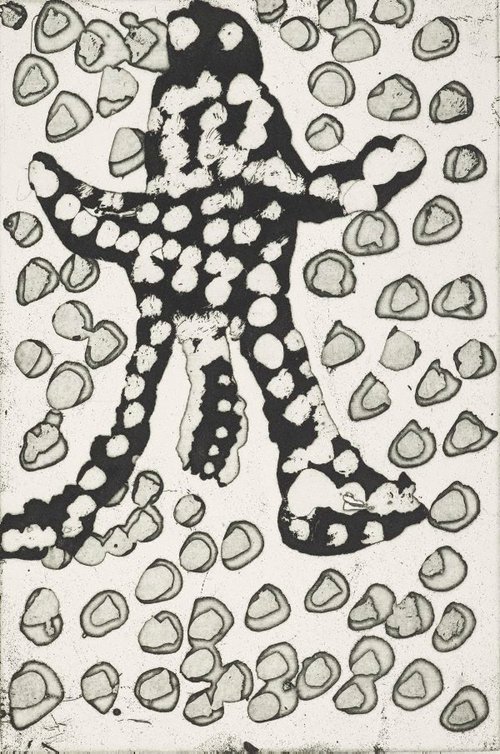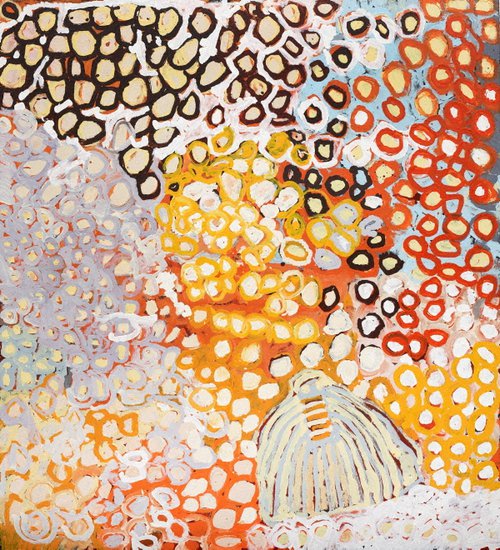Harry Tjutjuna
Australia
Born: Pukatja (Ernabella), South Australia, Australia circa 1930
Died: Pipalyatjara (Mount Davies), South Australia, Australia 2020
Language group: Pitjantjatjara, Southern Desert region
Biography
Harry Tjutjuna was born around 1930 deep in the heartland of his Pitjantjatjara country at Kali Tjukaru (or Walytjatjara), north-east of the present-day community of Pipalyatjara near the tri-state border of South Australia,Northern Territory and Western Australia. Tjutjuna is a respected senior artist, lawman and ngankari (traditional healer) within the Anangu Pitjantjatjara Yankunytjatjara (APY) Lands. Throughout his life Tjutjuna has experienced massive change, from living a traditional life on his country, working on stations, and now as an acclaimed artist. When he was a young boy his family moved into the recently established Presbyterian mission of Ernabella in the east, and he attended school. As a young man he actively worked for the community, sinking bores, fencing, gardening and farming. His skills, family connections and cultural responsibilities saw him move extensively around the APY Lands, including to Wingellina (Irrunytju) working as a stockman.
In 2005, after returning to Ernabella, now known as Pukatja, Tjutjuna focused on painting at the local art centre, Ernabella Arts. Together with a handful of other men, he strengthened the representation of male artists from Ernabella. In 2008 Tjutjuna moved to Pipalyatjara, and now works through Ninuku Arts Centre at nearby Kalka. Tjutjuna’s paintings immediately gained recognition for his unique style and personal depiction of Tjukurrpa, which often focuses on heroic ancestral male figures and their actions. Included in his repertoire are Wati Ngintaka (Perentie Lizard Man) and Wati Nyiru, the male protagonist in the region’s epic Kungkarrakalpa (seven sister) Tjukurrpa. Through painting these Tjukurrpa, Tjutjuna connects and identifies with his ancestors, with Wati Wanka (Spider Man) being his most favoured subject. Wanka is a ngankari, like Tjutjuna, who stated that:
He is a powerful and clever man. When rain comes, he hides in his nest. At night time, he changes colour. His name is Wati Wanka (Spider Man). Minyma wanka tjuta (a group of female spiders) are the women and all the children for this man. That’s the story. I am the spider man.
The colourful Wati Wanka, with his distinctive body markings and anthropomorphic legs, takes centre stage in the work Wanka (Spider), 2011, which can be seen as a self-portrait. Around him, the image is filled with a network of overlaid circles, referencing not only the spider web but the Minyma wanka tjuta (spider women) and children of Wanka’s family with the marks made in traditional sand drawings used to teach and tell stories throughout the desert. Tjutjuna sits within the elite network of senior Pitjatjantjara men painters, including Dickie Minyintiri (born c.1915) and the late Tiger Palpatja (c.1920–2012), whose works are dominated by active, gestural sweeps of paint that create vigorous constructions with a flamboyant, yet masterful use of colour. These senior men sit within their own school of painting, and have created a new visual language of the desert. Tjutjuna is well known for his cultural strength and dedication to the maintenance and teaching of culture to the next generation, stating: ‘New generation got to learn Tjukurrpa.
Jonathan Jones in 'Tradition today: Indigenous art in Australia’, Art Gallery of New South Wales, Sydney, 2014






